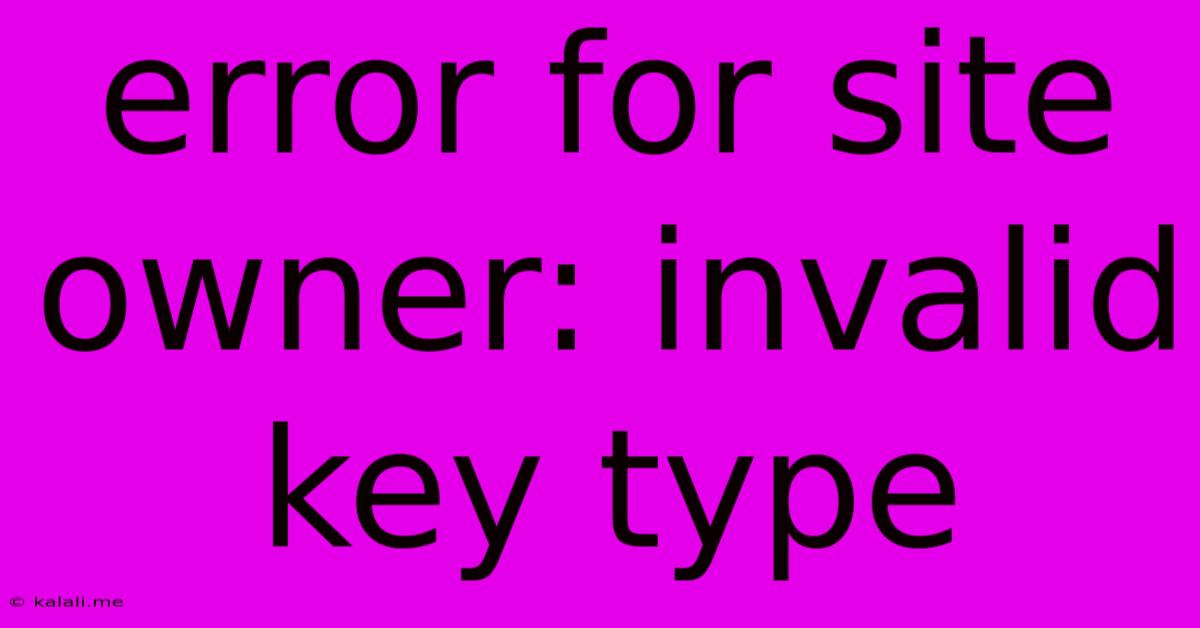Error For Site Owner: Invalid Key Type
Kalali
May 21, 2025 · 3 min read

Table of Contents
Error for Site Owner: Invalid Key Type – Troubleshooting and Solutions
This article addresses the frustrating "Invalid Key Type" error frequently encountered by website owners. This error, usually related to database interactions or API keys, can bring your website to a standstill. We'll explore the common causes, provide troubleshooting steps, and offer solutions to get your site back online. This guide will cover various scenarios and programming languages, providing a comprehensive understanding of this error.
The "Invalid Key Type" error typically arises when your application attempts to use a key (e.g., a database key, an API key, or a cryptographic key) that doesn't match the expected data type. This mismatch can occur due to several reasons, including incorrect data entry, incompatible libraries, or flawed code logic. Understanding the context of the error is crucial for effective troubleshooting.
Common Causes of the "Invalid Key Type" Error
-
Incorrect Data Type in Database: This is a prevalent cause. If your database schema expects an integer (INT) type for a primary key, and you try to insert a string (VARCHAR) value, you'll encounter this error. Similarly, discrepancies between the defined data type in your database and the data type your application uses can cause issues. Double-check your table schemas and the data types of variables in your code.
-
API Key Mismatch: When integrating with third-party APIs, ensure your API key is correctly formatted and of the expected type. Many APIs require specific key formats, such as hexadecimal strings or UUIDs. Review the API's documentation to confirm the required key type and ensure your application is sending it correctly. A simple typo can lead to this error.
-
Cryptographic Key Issues: If you're working with encryption or digital signatures, ensure that your cryptographic keys are correctly generated and handled. Issues like using the wrong key size or attempting to use an incompatible key algorithm can trigger the error. Verify that the key generation and usage conform to the chosen cryptographic library's specifications.
-
Type Juggling Problems (PHP, JavaScript, etc.): Some programming languages perform automatic type conversion (type juggling), which can sometimes lead to unexpected results and the "Invalid Key Type" error. Explicitly casting your variables to the correct data type can prevent these issues. For instance, in PHP, you might use
(int)$variableto ensure the variable is treated as an integer. -
Outdated or Incompatible Libraries: Using outdated or incompatible libraries can lead to unforeseen errors, including this one. Ensure that all your dependencies are up-to-date and compatible with each other. Check for updates and resolve any compatibility conflicts.
Troubleshooting Steps
-
Identify the Source: Pinpoint exactly where the error occurs in your code. Error messages often provide line numbers or function names to guide you.
-
Check Data Types: Carefully review the data types of all variables involved in the operation that triggers the error. Compare them to the expected data types defined in your database schema or API documentation.
-
Inspect API Documentation: If the error relates to an API key, consult the API's documentation thoroughly. Verify the correct key format, type, and usage instructions.
-
Test with Simple Values: Create a simplified test case to isolate the problem. Use known good values to rule out data-related issues.
-
Examine Database Schema: Ensure your database tables are correctly designed and that the data types align with your application's requirements. Run queries to check the data types of your columns.
-
Update Libraries: Upgrade your libraries and frameworks to their latest versions to benefit from bug fixes and compatibility improvements.
-
Review Code Logic: If the problem persists, carefully review your code logic for any potential flaws or inconsistencies that might lead to incorrect data types being passed to the operation.
-
Debug Your Code: Use debugging tools to step through your code line by line, inspecting variable values and identifying the exact point where the error occurs.
By following these troubleshooting steps and understanding the potential causes, you should be able to effectively resolve the "Invalid Key Type" error and restore your website's functionality. Remember to always prioritize secure coding practices and maintain up-to-date libraries and frameworks.
Latest Posts
Latest Posts
-
Which Word Has The Most Positive Connotation
Jul 15, 2025
-
How Do I Send An Evite Reminder
Jul 15, 2025
-
When Performing A Self Rescue When Should You Swim To Shore
Jul 15, 2025
-
How Many Decaliters Are In A Liter
Jul 15, 2025
-
What Note Sits In The Middle Of The Grand Staff
Jul 15, 2025
Related Post
Thank you for visiting our website which covers about Error For Site Owner: Invalid Key Type . We hope the information provided has been useful to you. Feel free to contact us if you have any questions or need further assistance. See you next time and don't miss to bookmark.